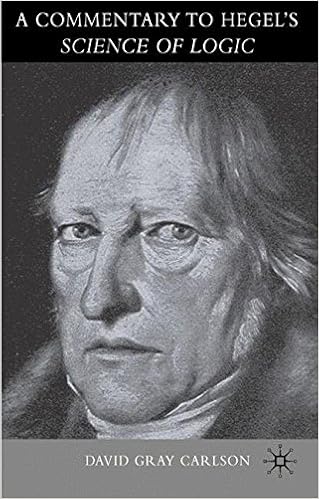
By David Gray Carlson
Hegel is thought of as the top of German idealism and his paintings has gone through a big revival when you consider that 1975. during this booklet, David grey Carlson offers a scientific interpretation of Hegel's 'The technological know-how of Logic', a piece mostly ignored, via a process of available diagrams, selecting and explicating each one of Hegel's logical derivations.
Read or Download A Commentary to Hegel's Science of Logic PDF
Similar Epistemology books
What Is Your Dangerous Idea?: Today’s Leading Thinkers on the Unthinkable (Edge Question Series)
The world's top clinical thinkers discover daring, striking, perilous rules which may swap our lives—for higher . . . or for worse . . . From Copernicus to Darwin, to current-day thinkers, scientists have continually promoted theories and unveiled discoveries that problem every thing society holds expensive; rules with either optimistic and dire effects.
From Abdullah to Hussein: Jordan in Transition (Studies in Middle Eastern History)
This booklet examines the main turbulent interval within the heritage of Jordan's ruling apartment, the six years following the assassination of the kingdom's founder, Abdullah (1951-1957). these years witnessed the country's lone episode of vulnerable monarchy, whilst the king--the amateur Hussein or his ill-starred father, Talal--was no longer the preeminent political actor within the land.
The Varieties of Reference (Clarendon Paperbacks)
Gareth Evans, the most marvelous philosophers of his new release, died in 1980 on the age of thirty-four. He were operating for a few years on a publication approximately reference, yet didn't entire it prior to his demise. The paintings used to be edited for e-book via John McDowell, who contributes a Preface.
Tooley the following units out and defends realist bills of conventional empiricist causes of causation and legislation of nature, arguing that in view that reductionist bills of causation are uncovered to decisive objections, empiricists needs to holiday with that culture.
Extra resources for A Commentary to Hegel's Science of Logic
Y) Transition of the Finite into the countless within the transition to the countless, Hegel introduces no new phrases, but, in a quick area, a brand new develop is defined. What we get are enriched observations relating determine 5(c). ninety one First, the certainty isolates the mediated parts of the Ought [4,5, 6]. right here the Ought 89 See HEGEL'S PHILOSOPHY OF NATURE 206 (M J. Petry trans. , 1970) ("the stones cry out and raise themselves to spirit"). Of this passage Errol Harris feedback that it "may be basically poetic enthusiasm, yet is however a suggestion packed with medical premonition. " ERROL E. HARRIS, T H E SPIRIT OF HEGEL 116 (1993). ninety 'The essence of the inorganic factor is actually a specific decision, that is why it turns into idea in simple terms in its connection to different issues. however the factor doesn't look after itself in that connection; it is just for-some-other; it doesn't contemplate itself within the means of on the subject of different issues . . . those parts are specific determinations, and so they lack mirrored image on themselves, that's, they current themselves as being forothers. " HYPPOUTE, GENESIS, supra be aware forty nine, at 240-1. ninety one in response to Andrew Haas, "Assuming that the common sense is then a computing device functioning alongside [an] immediacy/negation/mediation blueprint, divided into "trinities," into 3 subsections each one with the moments, is deceptive. in reality, the tripartite constitution is consistently interrupted; for instance, in "Quality," the part entitled 'Transition" is a complement (it isn't really a 3rd and has no three). " ANDREW HAAS, HEGEL AND the matter OF MULTIPLICITY seventy nine (2000). I evidently disagree and locate triunity during this subsection of bankruptcy 2. ninety two caliber "contains obstacle, and hassle includes the ought. Their relation to one another is the finite itself which incorporates them either in its being-within-self. " (136) The being-within-self of the Finite is [4]. In [4], the Finite includes either the Ought and obstacle. through advantage of those observations, the Finite of the transition is extra robust than the Finite of determine 5(c), during which the Ought and problem have been in simple terms implicit. Dialectical cause emphasizes that what seems to be a self-identity [1] has a unfavourable voice [2], which means one other Finite [3]. As Finite, [1] ceasesFigure 6(a) to-be and the recent Finite [3] comes-to-be Enriched Finite because the first Finite's adverse. the opposite Finite [3] likewise ceases to be and turns into the previous Finite [1]. we've the ceaseless seething turmoil of [1] - [3] - [1]. Of this technique of delivery and demise, Hegel says, "the finite in its ceasing-to-be . . . has attained its being-in-itself, is united with itself" (136) The in-itself has manifested itself during this ceaseless job. The in-itself of the Finite is the act of death. right here we have now a harbinger previous nonetheless the fates, and prologue to the omens approaching. Being is set to die. not just is the Finite for itself while it ceases to be, however it issues to its different: "the ought transcends the dilemma, that's, transcends itself; yet past itself or its different, is simply the predicament itself.



